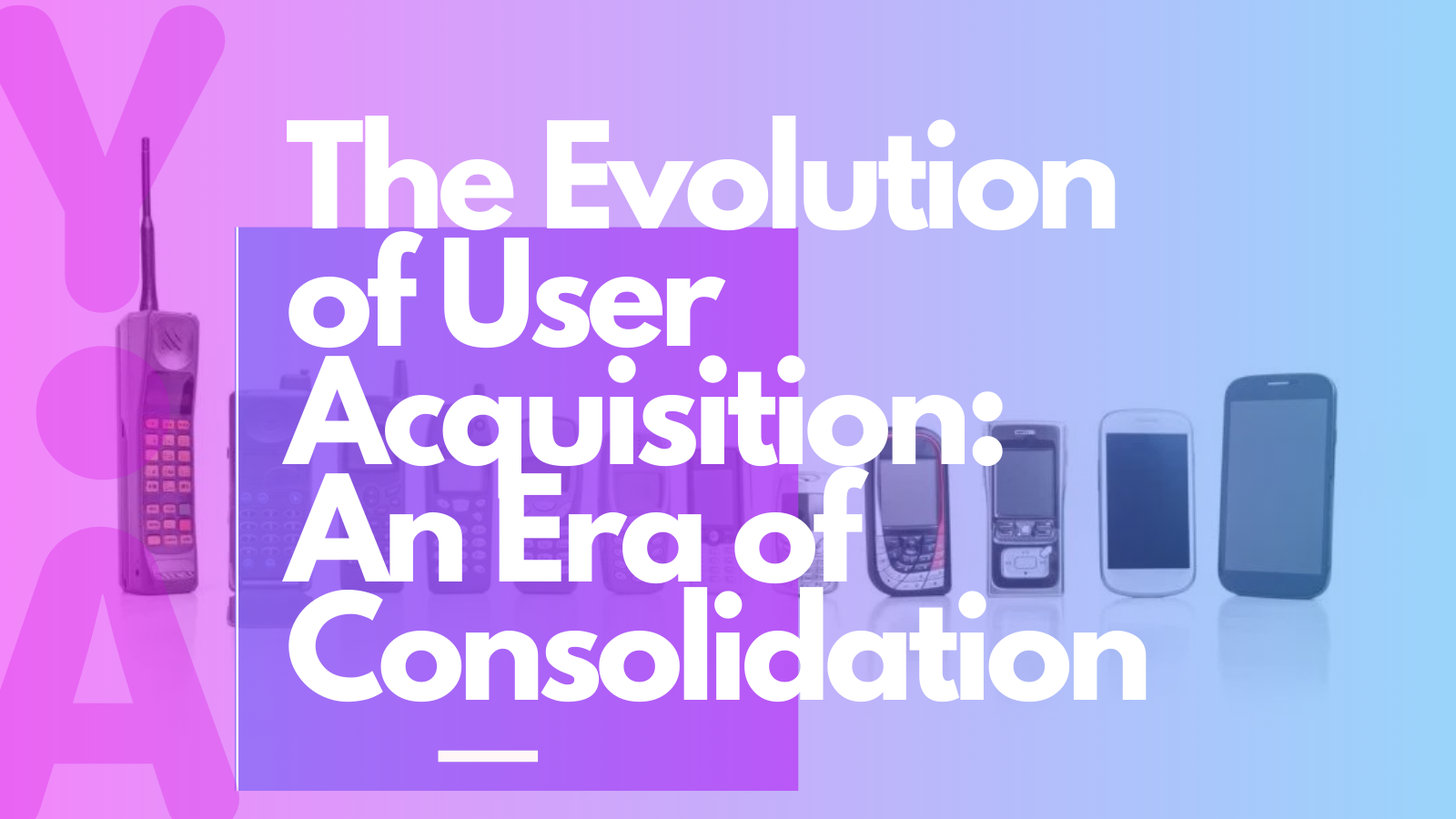If you’ve been in the mobile industry in the last decade or even just owned a smartphone, you have probably noticed that apps and the way we interact with our devices have evolved dramatically. The debut of the first-generation iPhone in 2007 literally changed the game of the mobile industry. In 2008, Apple launched its App Store with 500 apps and we never looked back. Today, there are 3.4 Million apps available to download using a mere thumbprint.
As users, we understand how these changes have affected us personally – but from a user acquisition perspective, how are companies gaining and maintaining users when there is so much competition?
Here, we dive into the evolution of user acquisition (UA) - the method of acquiring new users to an app through marketing activity - in the era of ad tech consolidation. Let’s start at the beginning of mobile programmatic advertising.
The Birth of Mobile Programmatic Advertising
Apple launched its App Store in July of 2008 and by the end of that year, the Android Market opened its doors - marking the inception of mobile advertising as we know it. In this early period, advertisers measured success mainly on gross user volume. Publishers measured this key performance indicator (KPI) by tracking click-through rates (CTR), an indication of basic user interest. While advertisers were so focused on growing basic engagement, they overlooked the fact that clicks don’t always result in installs – and, further, that installs drive revenue.
It’s safe to say that clicks are not the main focus of user acquisition and programmatic advertising these days — but hey, we were all getting used to this new era of tech in the 2000s 🤷🏻♀️
The Progression of ROI
By 2012, advertisers shifted focus to encourage app installs and to gain high-quality users that continue to interact with the app over time (aiming to steer away from lapsed or dormant users). Mobile companies started studying user behavior and preferences through A/B testing and different creatives to enhance the overall user experience. This was when marketers really started to hone in on exactly what resonated with users in the long-term rather than focus on short-term growth goals when it comes to mobile programmatic advertising.
The concept of measuring success by looking at the lifetime value of a user (LTV) didn’t come to the forefront of mobile marketing until 2016. Advertisers realized generating revenue is more likely when a high LTV user conducts a series of post-install actions. Take for example when a user purchases a monthly subscription or tokens within a game. This event is where the real money was being made so naturally, it made sense to capitalize on this strategy.
This realization spurred app developers to fine-tune their marketing campaigns to look at down funnel data (post-install events). App developers started optimizing marketing campaigns to target post-install events and, consequently, attribution tracking (which tracks the user journey, allowing advertisers to identify the most profitable marketing channels) started becoming more sophisticated.
Are these strategies starting to sound more familiar? 🤔
One key for attribution tracking is the IDFA (Identifier for Advertisers). This is an identifier assigned by Apple to a user's device to measure how individuals interact with ads and behave along the user journey. Advertisers use the IDFA to deliver customized and personalized ads and as a key to measuring the success of campaigns back to the user. Google has its own way of tracking and identifying users (known as GAID) that follows the same method.
So what happens if these identifiers are taken away?
Current Programmatic UA Advertising Strategies
Flash forward to the present day – here we are in the age of IDFA-less tracking (thank you, Apple), programmatic user acquisition advertising, and ad tech consolidation. The user acquisition strategies implemented back in 2007 where the most important metric was CTR and simple growth of an app audience no longer cut it in the world of constant competition and innovation. Programmatic UA advertising is at the forefront of UA strategies. If you’re not acquiring users with real-time bidding and optimization algorithms, my question for you is “why not?”
Programmatic UA advertising is more accurate than the days of yore and the old campaigns run through ad networks. This new school of running UA uses machine learning to optimize media buying, reach campaign goals, and control campaigns. It brings the focus back to revenue and quality rather than installs to ensure campaign success.
Ad-Tech Consolidation
The anticipation of the new iOS changes was top of mind for everyone in mobile over the last few years. It was less a question of “will it happen?” but rather “when will it happen?”. The implementation of privacy restrictions by big tech players like Apple (with Google following suit) set limits to the data advertisers can access from users. This makes serving personalized ads in the quest of growing an audience difficult for advertisers. So, how have leaders in the industry responded to this change?
One response to these shifts in privacy is consolidation – when two or more companies merge and operate under the same umbrella.
In the last year, we have seen multiple companies go through M&A (90 total deals were struck in the last year, an 82% increase overall) to maximize the chances of success in this new era of growth marketing. In 2021, mobile game publisher Zynga acquired in-app growth and mobile monetization platform, Chartboost for $250 million in cash. The main reason for this acquisition? To access and synthesize complex data.
“Zynga is a major game developer with its own first-party data. As such, the acquisition of an ad tech company that serves mobile ads will allow Zynga to leverage its first-party data for a full ad tech stack.” says Moshe Vaknin, CEO and Founder of YouAppi. “...major gaming app companies that also include a fully-owned, proprietary attribution stack would be particularly valuable in a post-iOS 14.5 world.”
This same strategy of companies merging to thrive in times of change has been repeated throughout the last few years and is on track to continue in 2022. But, is consolidation really a necessary step when it comes to user acquisition?
Why Industry Consolidation - The Rule of Three
The idea of bigger players buying up smaller ones can be daunting. Adtech consolidation has been on the horizon since the inception of mobile marketing. In fact, it’s beneficial not only to users, but to advertisers as well.
When the mobile app industry began to expand in the late 2000’s, the number of ad networks increased as well. In response to this demand – the industry started to experiment with new growth technology to keep up with the accelerating competition and innovation (as seen in the evolution of UA). While having more networks in the game is inevitable, so is reaching a point of inefficiency, resulting in excess capacity and fragmentation in the industry. Eventually, this led to an industry reckoning of mergers and acquisitions with larger, more sophisticated firms leading the way —ultimately, landing on three major players to lead the pack. This phenomenon is called The Rule of Three.
A great example of this is with car manufacturers. For example, in the early 1900’s there were approximately 2,000 car manufacturers in the US. By 2016, there were only about three dominant players (Ford, GM and Chrysler), with smaller brands mixed in.
Consolidation gives advertisers the ability to produce a higher quality product by merging experts in every aspect of the mobile space. With the constant changes in user acquisition and mobile growth, having top players come together to produce more efficient growth strategies is crucial.
Will the current consolidation craze in ad tech shake out to just three players in the end? And, what new programmatic user acquisition advertising strategies will come into play in 2022? I guess we’ll just have to wait and find out!
History of Programmatic UA Advertising Takeaways:
Mobile app advertising has come a long way since its inception in 2007. From measuring the success of user acquisition through tracking click-through rates nearly a decade ago to dealing with privacy changes and major consolidation in the current AdTech landscape. App publishers are seeking innovative tactics to grow their user base while also complying with new challenges in the space. What have we learned in the evolution of UA?
- Maintaining users is more important than ever as there is ever-growing competition. The App Store went from having 50,000 apps available in 2008 to over 3.7 million in 2021. This highlights the importance of accessing high LTV users in a crowded mobile landscape.
- Advertisers need to be agile, rolling with the punches when it comes to growing their user base. The old strategy of measuring success strictly based on installs is out. Quality and revenue are in.
- Welcome to the era of consolidation: we are seeing more mergers and acquisitions than ever before in the mobile space (90 total in the last year - an 82% increase in deals overall). Companies are merging to scale their skill sets in an increasingly competitive market and minimize the effects of big tech’s privacy changes. Consolidation is expected and inevitable in a thriving and growing industry!
Have Questions about Programmatic UA Advertising?
Shoot us a message and we will help your app marketing campaign sail through 2022 smoothly.


